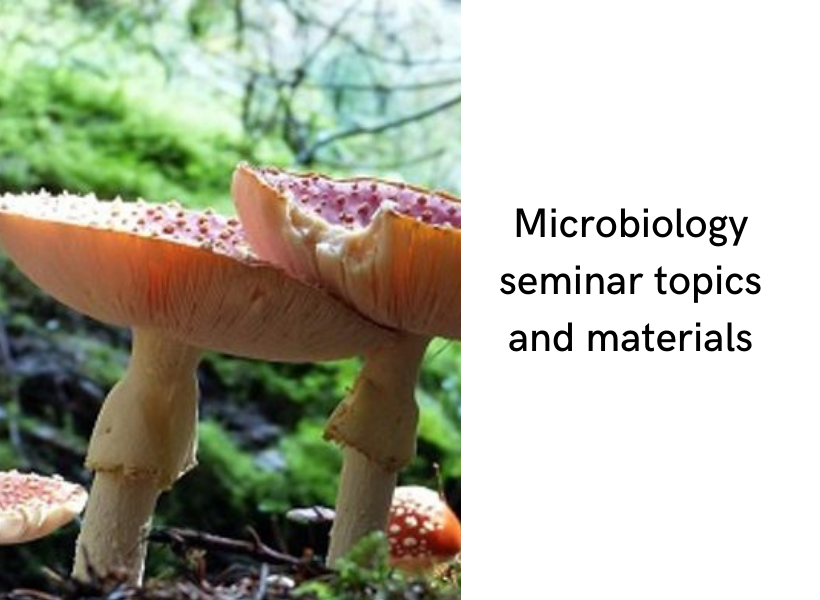If you have to present or write a seminar paper in Microbiology we have put together some interesting microbiology seminar topics available in pdf documents for you to look at.
You may get more inspiration for related topics you can use for your seminar work.
Selected Microbiology Seminar Topics
Plasmid Profile Of Streptococcus lactis And Lactobacillus Plantarum Isolated From Ogi Encoding For Acetaldehyde In Yoghurt
11 Pages
2. 16s rRNA Gene Sequencing: A Practical Approach To Confirming The Identity Of Food Borne Bacteria
One of the main challenges for clinical practice and public health surveillance is rapid and accurate identification of food borne pathogens. In Nigeria, the use of sophisticated molecular tools for foodborne pathogens detection has not been extensively adopted.
13 pages
An average Nigerian household consumes vegetables of various kinds but are ignorant of their antibacterial properties and other benefits. There is also an increase in the prevalence of multidrug resistant strains of bacteria which has raised the spectra of untreatable bacterial infections
10 pages
4. The aftermath of COVID-19 pandemic in the Nigerian Society
The world economy has been crippled by a novel coronavirus disease 2019 (COVID-19) which also put over 210 countries of the world in the map of epidemiology, in this case, our country Nigeria and Ekiti State as well is not left behind.
13 pages
5. Infectious Control in the Post Antibiotic Era
There are enormous challenges facing infection control in the 21st century. Countries across the world are confronted by ageing populations, restricted healthcare resources, demands for modern medicine and increasing antimicrobial resistance. Problem pathogens in the community are set to invade hospitals, and those created in hospitals are seeding into the community.
40 pages
6. Nanotechnology and its Place in Modern Medicine
Nanotechnology is the study and application of extremely minute structures known as nanomaterials. These nanomaterials have sizes ranging from 0.1-100nm. Nanomaterials are produced using two approaches which are the bottom up approach and the top down approach and have been applied to various fields including medicine.
38 pages
Ivermectin (IVM), a dihydro derivative of avermectin (AVM), originating solely from the fermentation products of Streptomyces avermitilis had an immeasurably beneficial impact in improving the lives and welfare of billions of people worldwide.
115 pages
8. TUNGIASIS: A NEGLECTED TROPICAL DISEASE
Tungiasis is an ecto-parasitic disease of humans and animals caused by the burrowing of gravid female fleas of the genus ‘Tunga’. Of the known species of Tunga fleas, Tunga penetrans and Tunga trimamillata are parasites of humans besides other warm blooded mammals, most of which are peri-domestic
33 pages
Environmental investigations show that the Archaea are diverse and abundant not only in extreme environments, but also in soil, oceans and freshwater, where they may exhbit a key function in the biogeochemical cycles of the planet.
17 pages
10. NOVEL CHEMOTHERAPEUTIC TARGETS FOR THE CONTROL OF SCHISTOSOMIASIS
Schistosomiasis is a water-borne parasitic disease caused by schistosomes and transmitted by fully aquatic or amphibious freshwater snails in whose bodies the human-infective larvae, cercariae, develop.
31 pages
11. Nosocomial Infections as a Factor in the Spread of Infectious Diseases
The basic idea of healthcare facilities which is to make people well is on the verge of being defeated as a result of patients contracting infections while in healthcare settings. Nosocomial infections are infections acquired by patients or healthcare workers while they are in healthcare facilities, including, hospitals, dental offices, nursing homes and doctors’ waiting rooms.
35 pages
Nutrient paucity in the soil poses challenge to global production of food. The use of synthetic nitrogen fertilizers to boost crop yield is a recurrent farming practice, despite their unfavourable effects and hazard to the environment and human population. This study was aimed at developing an environmental friendly, low cost inoculation technology for the cultivation of soybeans
15 pages
13. Health and Medicinal Benefits of Arugula Plant
Arugula is a collective name for a number of species of Brassicaceae with pungent leaves, but principally Eruca satia. Eruca sativa is an edible annual plan growing 20-100cm in height, leaves are deeply pinnately lobed with 4-10 small lateral lobes and commonly known as rocket salad, rucola, rugula, roquette and arugula. It is also an herb vegetable that belong to the Brassicaceae family and a native of central and southern Europe, but have also been spread to Northern America.
36 pages
14. Essentials of Microbiology in Forensic Medicine
Forensic microbiology as an evolving field in forensic medicine, is a scientific discipline dedicated to analyzing evidence from a bioterrorism act, biocrime through the study of microorganisms in order to determine the path of an outbreak, the identity of a criminal or the origin of a particular strain of biological weapon or contagion (Budowle et al., 2006).
20 pages
15. Pathophysiology of Ebola Virus
Ebola virus, a member of the Filoviridae virus family, is still an untamed, highly lethal viral pathogen that represents a nightmare for much of central Africa, which is the site of the majority of EBOV outbreaks (Geisbert et al.2010). Unfortunately there has not been a large push in the search for a vaccine as this virus, as deadly as it is, has not impacted a large portion of the world’s population with only 2,300 reported cases of hemmorraghic fever caused by filoviruses.
29 pages
16. PRODUCTION OF INSECTICIDAL COMPOUNDS USING BACTERIA AND FUNGI
Pest and diseases have a serious effect on food production. Global crop yields are reduced by 20 to 40% annually due to impact of pests and diseases.Indiscriminate use of insecticides to combat insect challenges, have increased the selection pressure leading to resistance in insects. In such a situation, alternate options of insect control are advocated. The use of microbial insecticidal compounds offer adequate levels of insect control and pose fewer hazards.
27 pages
You can dive into our database and search for more Microbiology Seminar Topics, as well as research papers.
